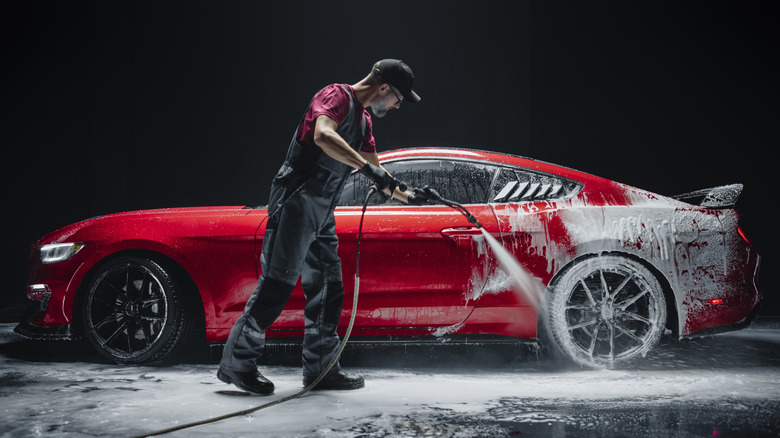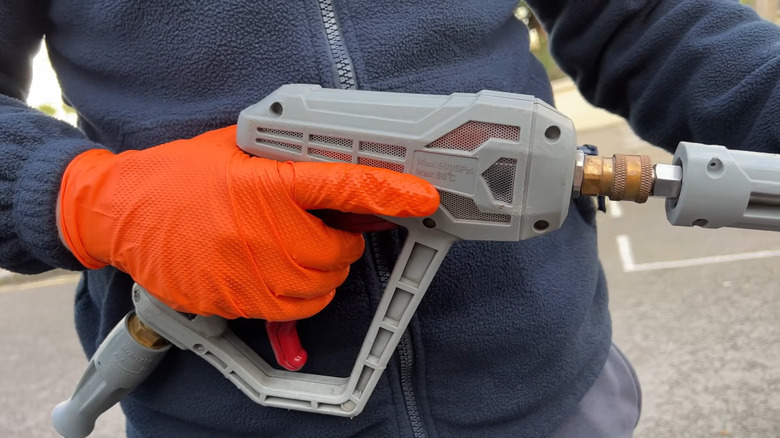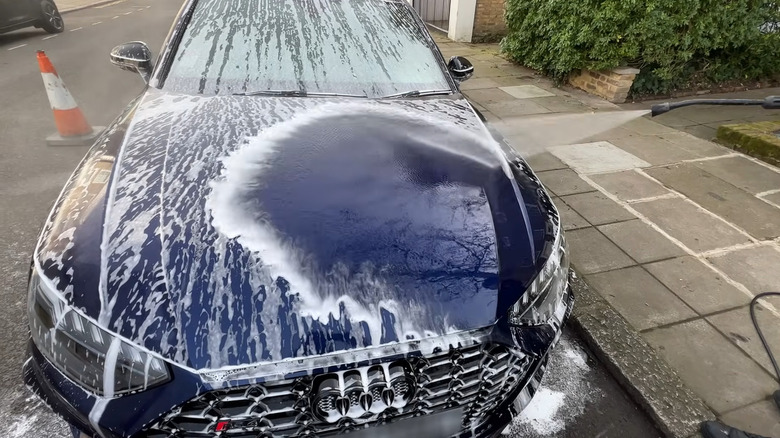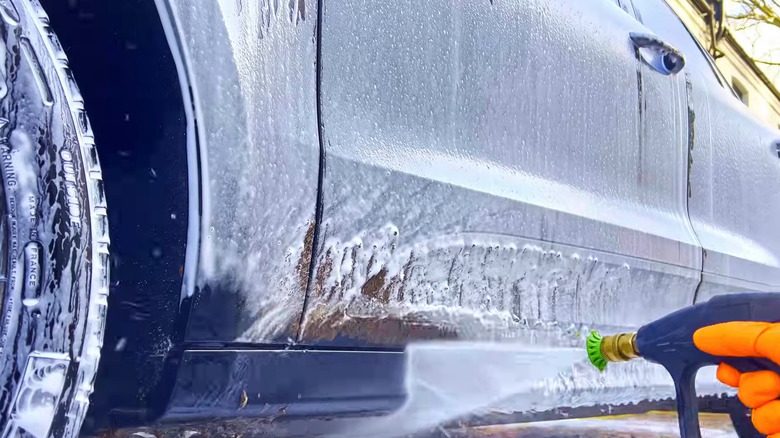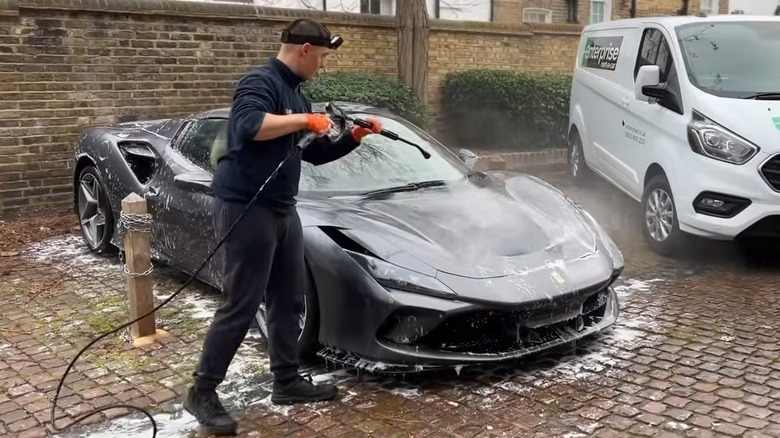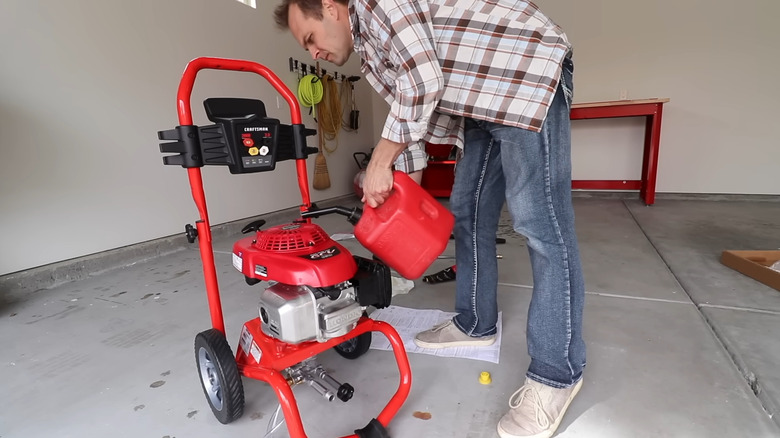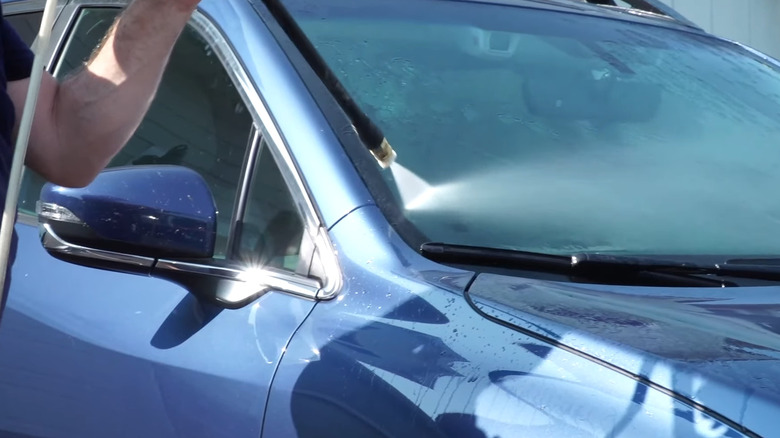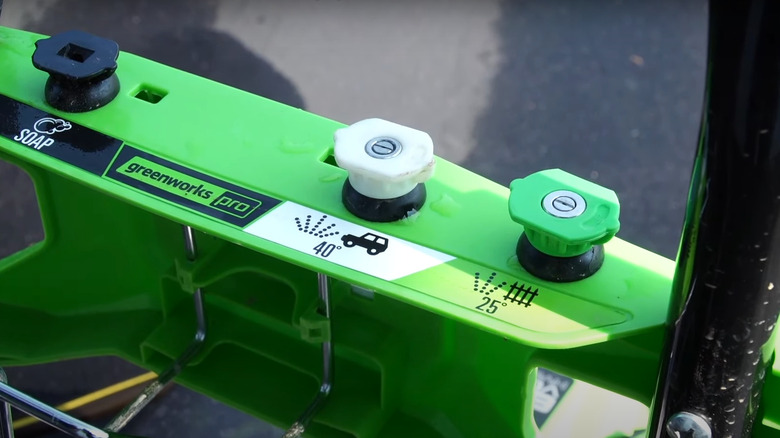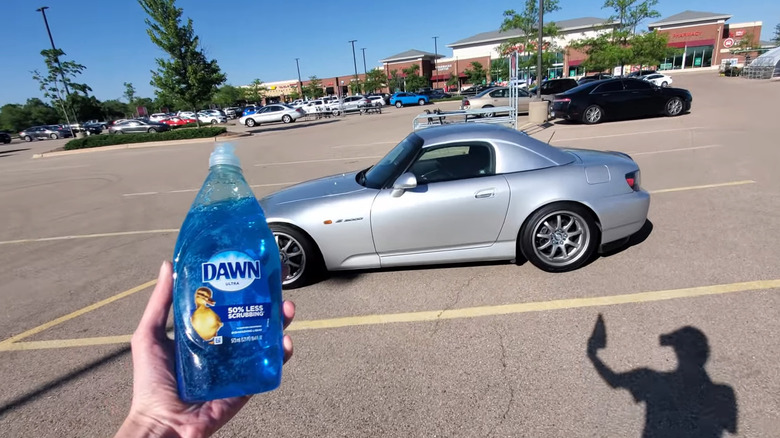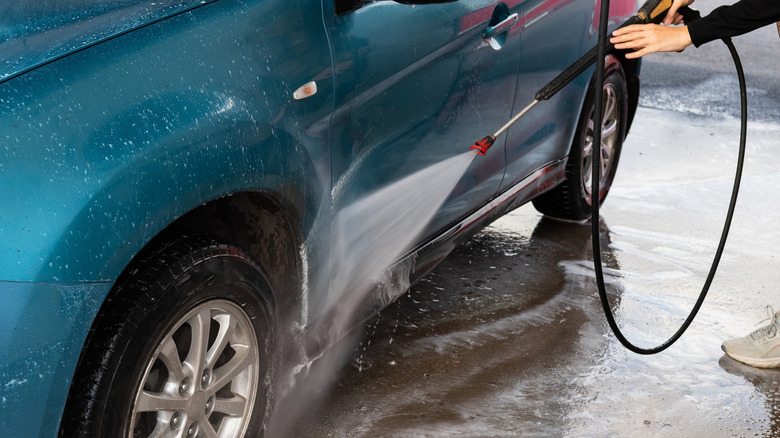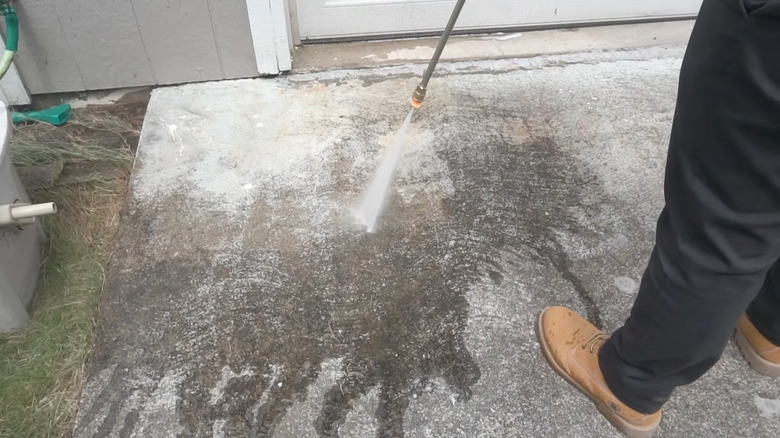Don't Let These 10 Pressure Washing Mistakes Ruin Your Car
We may receive a commission on purchases made from links.
In the years since Frank W. Ofeldt II discovered in 1926 that pressurized steam has excellent cleaning properties, pressure washers have become an integral part of cleaning around the house. From cleaning your driveway to bringing back the shine on your vehicle's paintwork, pressure washers can seemingly do everything.
However, while most people think they know how to use a pressure washer, faulty techniques are still widely used. This is particularly true for pressure washing cars, where improper use of these machines can lead to damaged paintwork and cracked windows. Dealing with highly pressurized water can be dangerous for the operator as well.
Let's take a closer look at all the malpractices people do when pressure washing their cars. This detailing journey will guide you through all pressure washing principles, so you can clean your vehicle more effectively, without damaging it. Before we start, it's important to note that pressure washing is only a part of the cleaning process — there are all sorts of other tools you need to properly detail your car.
Not using protective equipment (PPE)
Pressure washing your car is not the most dangerous job, but it can cause serious injury. Most notably, the detergents you'll be using contain chemicals you might want to keep off your skin and out of your eyes. Pressurized water can also cause debris like stones to fly at high speeds, potentially hurting you. Often producing upward of 2,000 psi, they can also easily injure your skin.
Protecting yourself to minimize risks is important. Start with a PVC raincoat made specifically for commercial purposes, like this one on Amazon. The raincoat will protect from flying debris, and also keep you dry. Combine it with rubber boots and heavy-duty rubber gloves. These should also be made for commercial purposes and thick enough to resist tearing. Make sure they also have enough grip, too — you don't want to be sliding around or fail to hold on to the pressure washer.
Finally, give top priority to your face and ears. Those harmful chemicals are especially bad for your eyes and can cause permanent injury, as can the potential debris, and the pressurized water itself. Do your eyesight a favor and purchase special goggles that fully enclose your eyes, and make sure they have an anti-fog feature, too. Or, even better, protect your face with a visor. Meanwhile, ear protection like earplugs or earmuffs will help keep your ear drums safe from the loud operation.
Applying detergent first (except touchless soaps)
The best course of action when washing your car is to first start by using the pressure washer. In this step, you'll want to use the power of your pressure washer to remove as much of the dirt as possible. By doing that, you'll minimize scratches when cleaning with detergent and wash mitts. Don't rush this step! Take your time on especially dirty parts, including hard-to-reach areas like the wheel wells. Once you finish, choose one of the best soaps for your vehicle to restore the paint's shine.
Still, many detailers have started using touchless soaps lately, which are best applied before rinsing your vehicle. These are much more powerful than regular detergents, cutting through stubborn grime more easily. The best part — in most cases, cleaning with a detergent and wash mitt won't be necessary, further minimizing scratches on the body paint. For best results with a touchless soap, you might want to invest in a foam cannon. This device attaches to your pressure washer and uses its power to create a thicker foam. Be careful, though, as applying too much soap might cause it to slide off more easily.
Starting from the bottom
This might seem like an obvious thing, but people sometimes forget about gravity. If you start pressure washing from the lower parts first, the dirt from the upper parts will still finish at the bottom and might cling to the surface. Again, removing as much dirt as you can with the pressure washer is crucial to keep your vehicle's paint shiny for longer. So, start with the roof, windows, and windshield. Then, work on the hood, front fascia, sides, rear end, wheels, and undercarriage.
However, in most cases, we recommend applying detergent bottom up. The lower parts of your vehicle are most often dirtier, and they should get as much soap as possible. In this case, you should be using gravity to your advantage. Car washing foams mostly cling to the surface, but not entirely. So, starting from the bottom will ensure the dirtier parts get more foam, and for longer. As for rinsing, you'll want to start from the top to ensure that dirt from the upper parts doesn't stick to the lower surfaces.
Using too much pressure
Cranking the pressure might seem appealing, especially if your car is very dirty. However, there is such a thing as an ideal psi for a pressure washer. You don't need too much pressure to remove most of the dirt. In fact, it's always better to use a car washing detergent to remove stubborn dirt and grime.
With that said, pressures ranging between 1,200 and 2,200 psi are sufficient for cleaning cars. Going higher than that won't yield better results. A stream that is too pressurized and narrow can easily chip the paint off your vehicle. Very high pressures can even cause a dent in the bodywork and break glass.
While we are at it, the water flow rate also plays a role. It is expressed in gallons per minute (GPM), and the recommended figures range between 1.2 and 2.5. Flow rate is important; the higher the figure, the more water to clear off the debris. However, going too high will just do more damage without offering a meaningful advantage.
Using gas-powered pressure washer
Pressure washers aren't only used for cleaning cars. People also use them to clean residential surfaces, like driveways, roofs, cladding, and windows. Predictably, there is a great variety of pressure washers designed for different tasks. The two main pressure washer categories are gas and electric, and they have different uses.
Gas pressure washers are more powerful, creating higher pressures to clean stubborn dirt and soil off your driveway. However, they are way too powerful to clean your car. Gas-powered machines produce pressure that's too high for the surface of your vehicle and might do damage. Moreover, they push more water through the nozzle, which can do further damage.
For reference, electric pressure washers produce pressure between 1,200 to 4,000 psi, with a flow rate of 1.5 to 2.5 GPM. Meanwhile, gas machines produce pressures between 2,000 to 5,000 psi. As we already learned, that's way too high for cleaning your vehicle. Moreover, their flow rate ranges between 2.5 and 4 GPM. Again, higher than the recommended flow rate of 1.2 to 2.5 GPM.
The high pressure and flow rate make gas pressure washers more difficult to control, too. This is particularly true when you hold the handle horizontally, like cleaning the sides of your vehicle. You can hold the handle more steadily when you aim at the surface, like when cleaning your driveway. Finally, gas pressure washers are loud, too, which can be problematic in residential areas.
Getting too close
Similarly to using high pressure settings, getting too close to the bodywork can also do damage. Even if the concentrated stream doesn't damage the paint, it could ruin any protective coat. Yet we still see many people trying to get rid of stubborn dirt from millimeters away.
Fortunately, there is an easy-to-remember rule in the detailing community for that, called "six-twelve" — 6 inches (15 cm) from the paint and 12 inches (30 cm) from the trim. Of course, you can get closer if your pressure washer produces lower psi, but to be safe, it's best to follow those guidelines.
However, you might want to refrain from using a pressure washer on damaged paintwork. For smaller scratches, you'll be fine, but pressurized water can open bigger wounds even more. This could then lead to rusting, which spreads easily to the rest of the bodywork. And rust repair can be a tedious and expensive process.
Using the wrong nozzle
Another crucial part of the A-Z book on pressure washing cars is using the right nozzle. These control the intensity and angle of the water spray, which significantly changes the cleaning properties. Luckily, they are color-coded, so that you don't make the mistake of using the wrong one.
Naturally, you would think that going for the tightest 0-degree (red) nozzle would be best for removing dirt. However, this one produces too narrow and concentrated a stream, and will easily damage the paintwork. Use it on concrete and metal, but never on your car. The 15-degree (yellow) nozzle is also too concentrated for cleaning your vehicle, though you can use it for your driveway.
The nozzle you'd be using regularly on your vehicle is the 25-degree (green) one. However, you only want to wash the wheels, tires, and undercarriage with the green nozzle, because its stream is still too powerful for the paintwork. For the rest of the car, the 40-degree (white) nozzle is king. Powerful enough to remove dirt, but easy on the paint, it is your best friend when cleaning your car.
For the best possible cleaning, it's best to switch between the green and white nozzle. Most people will find this arduous, but it's quick and easy. Fortunately, Ryobi makes an excellent and affordable 5-in-1 washer nozzle, where you can adjust the angle (0-degree, 25-degree, and 40-degree) and intensity on the fly!
Using soaps not designed for pressure washers
Dishwashing soap isn't the best solution for cleaning your car, and especially if you're thinking about using it with your pressure washer. It won't do a good job cleaning dirt off your car, and it can also gum up and damage the tubing. Keep these things in mind before opting for this low-budget solution, because you'll end up paying more in the end.
What you need is a detergent that's designed for pressure washers and also foam cannon ready. These produce a thick foam that will stick to the paintwork and work its way through the dirt. Fortunately, most of the latest car shampoos work with foam cannons, though you'll need to dilute them according to the manufacturer's recommendations, as otherwise they won't work properly. For best results, we recommend using distilled water. Also, to minimize environmental damage, only use biodegradable soaps and detergents.
Holding the nozzle at an incorrect angle
The angle at which you hold the nozzle is also a significant factor in cleaning your car without damaging it. Going too tight might create higher pressures, but it won't clean the dirt as efficiently. Instead of blasting it from the top, you should be lifting the soil from below. However, going too wide will lower the pressure at the attack point, and cause water to go over the dirt instead of penetrating it.
As a general rule of thumb, a 45-degree angle is recommended to ensure efficient cleaning, without damaging the paint. The same is true for cleaning and rinsing, though you can adjust the angle slightly to increase/decrease the pressure on some points. Crucially, following a 45-degree angle is natural for most people, and pretty comfortable. Oh, and don't forget to hold the nozzle downward to ensure that all the dirt finishes on the ground, instead of splattering all over your vehicle.
Cleaning your car on a dirty surface full of debris
You can wash your vehicle the old-school way (shampoo, sponge, and a hose) on pretty much every surface without worrying about damaging the paintwork. However, pressure washing is different. Highly pressurized water can lift larger stones from the ground and eject them at high velocities. These can then significantly damage the paintwork, and even crack a vehicle's window.
So, avoid pressure washing your car on surfaces with debris and loose stones, like gravel, grass, or soil. Older asphalt can also have weaker spots, like small, cracked parts that pressure washers can also eject at higher velocities. It should also go without saying that pressure washing on dirt can get messy, with mud splattering all over your vehicle.
The best surfaces you'll want to park your vehicle on are concrete or pavement. These can be easily cleaned beforehand, have excellent drainage properties, and are pretty durable. Ideally, you want a level surface with proper drainage, as dirty water can pool around the car.
